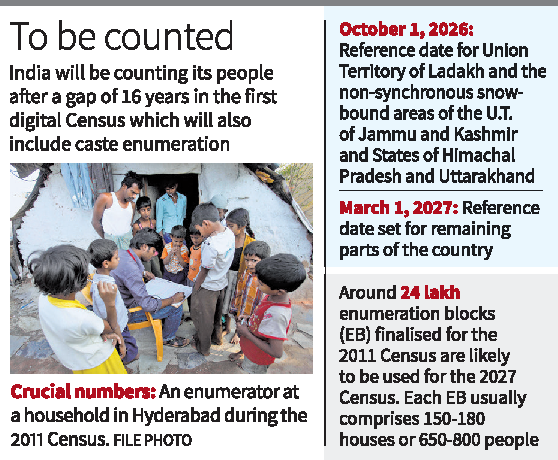Census in India

×
![]()
Census in India
I. Prelims-Oriented Points (Factual & Objective)
1. Legal Framework & Authority
Census Act, 1948: Governs the Census in India.
Union List (Entry 69): Census is a Central subject.
Key Functionaries:
- Registrar General and Census Commissioner appointed by the Centre.
- Directors of Census Operations appointed at the State level.
- Census staff mostly consists of school teachers appointed by local authorities.
2. History of Census in India
References found in:
- Kautilya’s Arthashastra (ancient India)
- Ain-i-Akbari during Akbar’s reign
First synchronous modern Census: 1881, conducted under W.C. Plowden
Held every 10 years since 1881 (uninterrupted till 2011)
Last Census: 2011
Caste enumeration last done fully: 1931
3. Phases of the Census
Phase 1: House Listing & Housing Census
- Duration: 5–6 months
- Data on housing type, water source, toilets, kitchen, fuel, electricity, assets (TV, computer, vehicle), etc.
- 2011: 35 questions in the house listing schedule
Phase 2: Population Enumeration
- Conducted in February of Census year
- Reference date: March 1
- Data collected: Name, sex, age, religion, SC/ST status, mother tongue, literacy, education, occupation, etc.
II. Mains-Oriented Points (Analytical & Policy-Relevant)
4. Delays in the 2021 Census
- COVID-19 pandemic delayed the 2021 Census.
- Despite conditions normalising post-2022, the Census has been repeatedly postponed.
- New reference date announced: March 1, 2027
5. Why the 2027 Census is Significant
Caste Enumeration:
- First time since 1931, the government will collect caste data of all Hindus (not just SC/ST).
- Responds to demands from opposition parties and civil society.
- Data expected to inform affirmative action and welfare policies.
Delimitation Exercise (Post-2026):
- Freeze on delimitation (as per 42nd Amendment, 1976 and 84th Amendment, 2001) ends in 2026.
- 2027 Census data may be used to reallocate Lok Sabha and State Assembly seats.
- Risk: States with high population control (South, Northeast) may lose representation.
Women’s Reservation Implementation:
- One-third reservation for women in Lok Sabha and State Assemblies will be implemented using 2027 Census data (as per 128th Constitution Amendment Act, 2023).
- Targeted for: 2029 General Elections.
6. Apprehensions from States
- Southern States, Northeastern States, and smaller North Indian States fear political marginalisation if seat allocation is strictly based on population.
- These States advocate:
- A freeze or alternative formula
- Preservation of their political weight despite low population growth
- Demand: Consensus-based approach before implementing delimitation.
7. Way Forward (Policy Recommendations)
- Caste enumeration should be accurate, scientific, and transparent.
- Delimitation must be consensus-driven and not rushed before the 2029 General Elections.
- Implement women’s reservation as scheduled using 2027 data.
- Respect federal balance and address demographic disparities in parliamentary representation.
